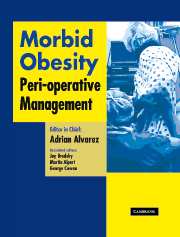Book contents
- Frontmatter
- Contents
- Contributors
- Foreword
- Preface
- Acknowledgments
- Dedication
- Section 1 General aspects
- Section 2 Pathophysiology
- 4 Lung physiology
- 5 Cardiac morphology and ventricular function
- 6 Pathophysiology of cardiovascular co-morbidities
- 7 Physiological changes during laparoscopy
- 8 Digestive physiology and gastric aspiration
- Section 3 Pre-operative management
- Section 4 Peri-operative management of co-morbidities
- Section 5 Pharmacology
- Section 6 Monitoring
- Section 7 Intra-operative management
- Section 8 Post-operative care
- Section 9 Conclusions
- Afterword
- Index
7 - Physiological changes during laparoscopy
from Section 2 - Pathophysiology
Published online by Cambridge University Press: 17 August 2009
- Frontmatter
- Contents
- Contributors
- Foreword
- Preface
- Acknowledgments
- Dedication
- Section 1 General aspects
- Section 2 Pathophysiology
- 4 Lung physiology
- 5 Cardiac morphology and ventricular function
- 6 Pathophysiology of cardiovascular co-morbidities
- 7 Physiological changes during laparoscopy
- 8 Digestive physiology and gastric aspiration
- Section 3 Pre-operative management
- Section 4 Peri-operative management of co-morbidities
- Section 5 Pharmacology
- Section 6 Monitoring
- Section 7 Intra-operative management
- Section 8 Post-operative care
- Section 9 Conclusions
- Afterword
- Index
Summary
Introduction
Bariatric surgery represents a true challenge, however significant accomplishments have been achieved in this field in the past decades. Complexity of surgery for morbid obesity lies mainly in the specialized care and knowledge required for successful pre-, intra- and post-operative outcome as well as for minimizing long-term complications and achieving substantial and lasting weight loss results (see Chapter 1).
Throughout surgical history, one of the main objectives has been to minimize operative trauma and improve peri-operative and post-operative outcome. There have been many different attempts to reach this goal. However until surgery has been invaded and overwhelmed by laparoscopy such attempts have been just of moderate success. Laparoscopic methods offered so far the least invasive approach with lower morbidity and mortality in comparison with majority of “classic” laparotomy procedures (Figures 7.1 and 7.2).
Furthermore, the laparoscopic approach offers early mobilization and rehabilitation, especially advantageous in bariatric surgery. Today, the advantages of laparoscopy have extended the technique to include a wide range of physical condition and ages.
Despite of advantages resulting in less post-operative pain, fewer pulmonary complications, faster post-operative recovery and often shorter hospital stay, laparoscopic surgery is associated with more pronounced intra-operative respiratory and cardiovascular changes than “open” surgery. As laparoscopy has moved from the young healthy patient undergoing mostly gynecological laparoscopies performed even under local or regional anesthesia in the 1970s and 1980s to a more diverse and obese population, presence of chronic medical conditions and co-morbidities has increased among the potential surgical candidates.
- Type
- Chapter
- Information
- Morbid ObesityPeri-Operative Management, pp. 81 - 88Publisher: Cambridge University PressPrint publication year: 2004
- 1
- Cited by

